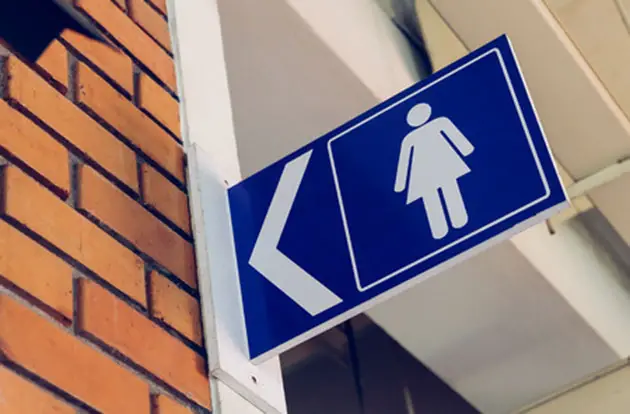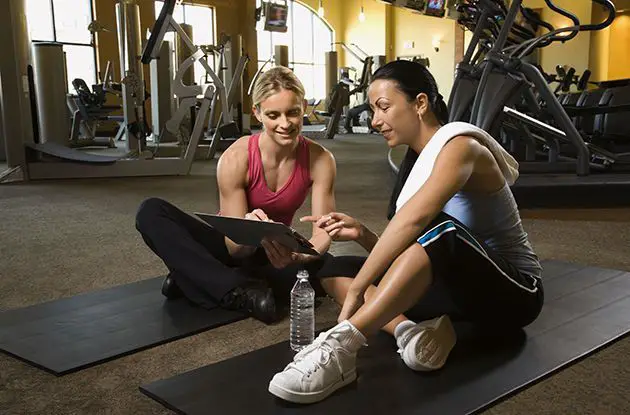A couple of months ago, I had heard two fabulous but scary words: “You’re pregnant!” Fearing the weight issue, my doctor had handed me a brochure on prenatal yoga that brought a lot of questions to my mind: How would yoga help me stay fit? I was hardly a yoga-devotee to start with. Was there a point to a class full of pregnant moms bending and stretching and just plain rolling around on the floor? Could yoga truly be a positive force when it came down to it, especially in the delivery room? Being the skeptic that I am, I decided to give prenatal yoga a try and see what the hoopla was all about. Would it be just another passing fad for pregnant women or could there be some substance in all of this? I signed up at Baby Om’s prenatal yoga class. Baby Om (www.babyom.com) was created in 1999 by yoga instructors Sarah Perron and Laura Staton after the births of their children. The two had found that teaching yoga throughout their pregnancies was a valuable experience. Wanting to share their experiences with others, they decided to turn their prenatal and postnatal yoga teachings into a business. Although they thought it would be a challenging adventure, they had no idea what was in store for them. “First it was just a cool idea,” Staton remembers. “ Now, it’s expanded into something so much bigger then we anticipated. We started with one class, one day a week, and now we have 10-12 classes a week all over Manhattan and in Brooklyn. It’s just a very happy subject for me.” But would this happiness translate into a positive experience, I wondered as I entered the studio. Inside, mothers-to-be were rolling out mats, carrying blankets and lightweight blocks to their places around the room. “Prenatal classes are a place of bonding. I think it makes you feel better to be around others in the same state and have a place to talk. The community experience is a great thing,” Perron explained. As I looked around the room, it did seem that we all had a lot in common. We were all visibly showing our pregnant physiques, while at the same time looking for a way to keep fit. My prenatal yoga community was just beginning. As I moved from a “downward dog” position into a “child’s pose” over and over again, I began to feel I was getting a small workout. I was actually sweating a little bit. I was beginning to understand how yoga could keep me fit. But, I still wondered, would I really use these poses when it was my turn in the delivery room? I spoke with Aly Mandel, mother of son Will and twin girls, Ava and Emily; Aly took prenatal yoga with Baby Om when she was pregnant with her twins. “I loved the class. Sarah was my instructor and she was so attentive to the twin pregnancy.” Mandel said. “The squatting and stretching all facilitated the delivery process. And the deep breathing and cooling breathing was such a big help to me,” As I took three deep cleansing breathes and “om’d” three times, my first prenatal class came to a close. I opened my eyes and couldn’t help but feel refreshed and renewed. Walking home, I pondered the possibility of other prenatal yoga teachers and their philosophies. Would their classes be different in any way? My curiosity led me to Mary Barnes, who has been teaching prenatal yoga for nine years. She feels her wonderful birth experiences with her two sons, Billy and Paul, were the result of what she learned from teaching prenatal yoga. “In my classes, I try to help women feel more empowered. I want to help them diminish the fear of pregnancy and teach them that their bodies contain real wisdom,” Barnes says. “I sometimes joke that anyone who lives in New York City is a Type A personality. With that I mean these personalities find it hard to back off, but that’s exactly what women have to do during pregnancy.” Through her certified “Barnes Method” (a combination of her own prenatal techniques and Anusara Yoga developed by John Friend), she finds teaching women poses that open the body help during delivery. Barnes also feels holding “couples workshops” is important in the prenatal yoga process. “I don’t want women to feel strange doing some of these things (positions, breathing, ‘oming’) so that is why I bring the labor partners in. They all leave with big smiles on their faces.” Barnes first taught in small studios, although now she teaches at five locations around the New York City area. She also teaches private lessons at a pregnant woman’s office or home. (Her website, www.yogafortwo.com, is under construction, but it will soon list these and other class locations). My quest for more information brought me to another program called B.A.B.Y., or Birth and Beginning Year (www.birthandbeginningyear.com). Founder Jamie Levine, an ACE certified Personal Trainer with a specialty in pre/postnatal fitness, began her company five years ago with a one-of-a-kind class called Dancing Thru Pregnancy. This program, created by Yale University over 20 years ago, was conceived as a safe way for pregnant women to engage in cardiovascular and strength training. “We have a cardio element to our classes and also provide a theme that we thread through each week of class,” Levine said. “Having the women focus on something they can bring with them throughout their pregnancy and into the delivery room makes us unique.” Over 3,000 women from Connecticut down to New York City have participated in Dancing Thru Pregnancy and Levine’s other class, Yoga Thru Pregnancy. In this prenatal yoga class, the focus is on the abdominal muscles. “We work with the inner most abdominal muscles,” Levine explains. “The deepest muscles that a woman uses to push her babies out.” With more and more women wanting to have it all — from staying in shape, to feeling a part of a community, to having something that makes them feel better while pregnant and in labor — prenatal yoga comes to the rescue!
Parenting Bookshelf
“Baby Om” — when baby joins the class
By Ben Spencer
“When you have your baby, suddenly you have responsibility,” says Sarah Perron, co-author, with Laura Staton, of Baby Om: Yoga for Mothers and Babies (Owl Books, $17). “But moms still have a need to focus on getting into shape. It’s constructive and it’s beautiful for them to focus on their own bodies because it eventually helps them focus better on someone else — their baby.” As both dancers and mothers, the pair knows quite a bit about being in shape, and the movements that make fitness possible. Staton, who grew up in Massachusetts and now lives in Brooklyn with her husband and two sons, has a BFA in Dance from The Juilliard School. Perron, who lives in Manhattan with her husband and daughter, is a graduate of the North Carolina School of the Arts; she later studied dance in New York City as a scholarship student with Martha Graham and Merce Cunningham. Neither is new to the practice of yoga — Staton took up the discipline as a teenager, Perron as a child. Their mutual interest dovetailed in 1999 with the birth of Staton’s first son and Perron’s daughter, resulting in the creation of their “Baby Om” series of popular yoga classes for mothers and babies. The lessons, in which moms are taught to incorporate their infants into various yoga positions, are now the subject of the duo’s first book. “What sets Baby Om apart is the integration of the baby,” Perron says. “We’ve seen a version in which the focus wasn’t on the baby — where the interaction with the baby was incidental. But very, very young babies are visual; they get visual stimulation from the activity, so by incorporating them into your poses you’re entertaining them, paying attention to them — and as a result, they end up feeling very comfortable.” Like all good instruction books, Baby Om’s illustrations make its lessons crystal clear at first glance. The poses are uncomplicated, presented in simple sequence photographs capturing the key moments of each pose. The text is sparse but thorough, describing the position of both mom and baby, along with tips (referred to here as “Essentials”), “What Ifs” (for troubleshooting), and “Cool Things” — namely, the individual benefits of each position. Less challenging variations are offered for slightly more involved poses. The chapters are divided by age: up to three months, three to six months, and six to 12 months. But the book also pays heed to yoga in regard to nursing, colic, and postpartum depression, along with a topic of personal importance to co-author Staton: Cesarean section. Staton, who had two Cesareans herself, says, “People who take yoga are into holistic things, and they want to have natural births. Women tend to approach labor as something they can control, which is great, but it doesn’t always work that way. When someone has a C-section, they tend to feel like they’ve failed, that they didn’t have a ‘womanly’ experience or an OK birth. When I had mine, there wasn’t any information in this area of postpartum recovery.” The combined experience of the authors, Staton believes, is what gives Baby Om its particular thoroughness. “During my first pregnancy, Sarah and I were only 10 days apart, so we could compare notes,” she recalls. “On my second one — well, that’s where we get a different sense of her body recovering from mine.” To make up for the lack of concrete and easy-to-understand information available to the layman in the areas of C-section, vaginal birth, and other medical issues, Staton recruited her sister Jennifer, a nurse practitioner specializing in women’s health issues, to offer her expertise as co-author of the book’s penultimate chapter, “Birth Process and Its Physical Impact”. “Here we want to tell people what’s happening,” Staton says. “We want to be as specific as possible — not just about cutting the stomach open and what happens then, but what you need to do for your body afterward.” Jennifer Staton also contributed (with Perron’s brother, Andrew D. Perron, M.D.) on Baby Om’s final chapter, “Postpartum Conditions” — touching on issues like Carpal Tunnel Syndrome, ankle swelling and pain, breast complaints, episiotomy, and lower back pain. Another distinctive feature of the book is its chapter on yoga as it relates to postpartum depression, for which another Staton sister, Johanna Simpson, a San Diego-based social worker, assisted. The chapter discusses frankly the subject of depression after childbirth, and the importance of using yoga as a mother/baby bonding technique and as a preventive measure. Staton says that it’s easier to reclaim physical conditioning after a first child, but that a second makes for “a longer climb back.” Still, she points out, the goal is not to “get back to the body you had, but to get yourself to the point where you’re strong and healthy, both physically and emotionally.”





















